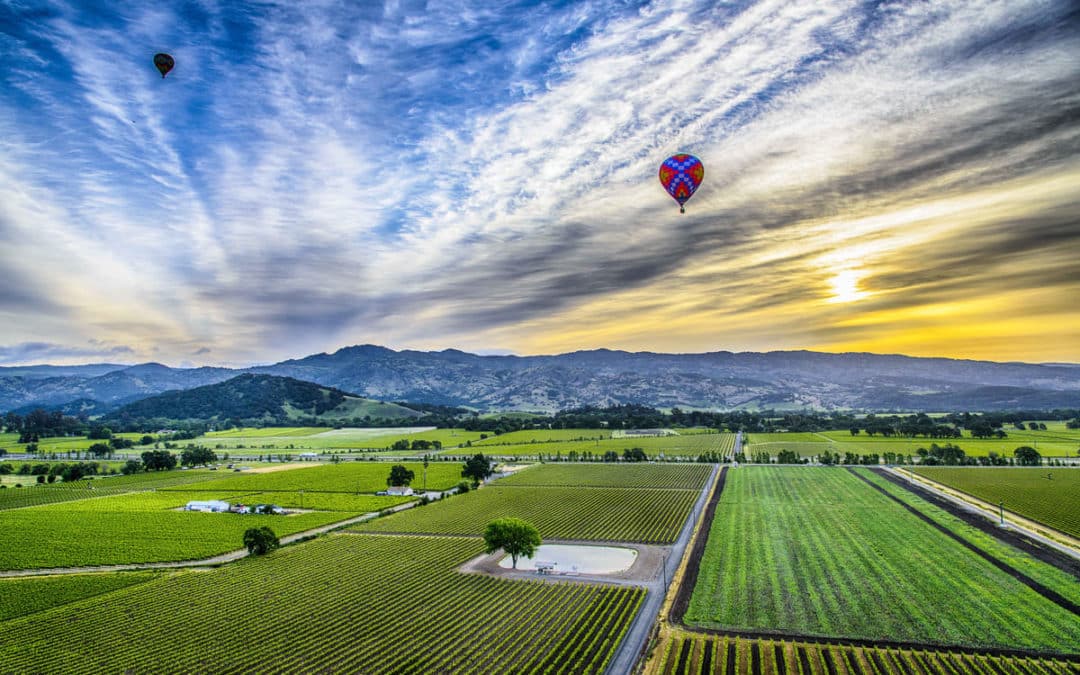During the past century, Napa Valley has become one of the world’s most important wine-producing regions in the world. The excellent climate, multiple soil types, and varying elevations of Napa Valley contribute to a spectacular growing environment for nearly all grape varieties. Winemakers from all over even relocated to establish new wineries in Napa Valley and nearby Sonoma County to take advantage of the excellent conditions.
Today there are currently over 800 wineries in Napa Valley and Sonoma County.
Through careful dedication to the science of viticulture, excellent and innovative crop and soil management practices, and experimentation, vineyard managers throughout Napa Valley and Sonoma County now produce the highest quality grapes for some of the most highly regarded wines in the world.
A Turning Point for American Wines: The Judgement of Paris
In 1976, the Bicentennial Year for the United States, a blind wine tasting event held in the then-Wine Capital of the World, Paris, France, ushered in a new respect for American wines.
Later known as the “Judgment of Paris,” an official tasting event organized by a reputable British wine broker featured a selection of French wines against a group of wines from the United States. The blind competition pitted Chardonnays from both countries plus a group of red wines from Bordeaux against Cabernet Sauvignon wines from California.
A shocking result for the judges and the wine world at large, the California wines were named Best in all categories. After the judgment was disclosed, one well-known French judge demanded the return of her ballot, fearing that her ruling would tarnish her local reputation.
As a result, the world’s wine lovers began to view California-produced wines, particularly Napa Valley’s, in a whole new light.
What is an AVA?
Wineries label each bottle with an Appellation of Origin that may define the country, state, or country where the grapes and the wine were produced. The attributes of wines from different locales and growing areas can differ significantly, even when made from the same grape varieties.
An important wine industry distinction in the United States is its AVA or American Viticultural Area. AVAs must be defined by some federally recognized political boundary like a county or a town.
Applying the federal AVA designation requires that 75% or more of the grapes used to make the wine must be from that appellation. And the finished wine must be produced entirely within the state where the AVA is located.
Napa Valley’s Initial AVA Designation
Although wine grapes were first grown in the region in the mid-1800s, Napa Valley received its official designation as an AVA, American Viticultural Area, in 1981.
In those early years, growers planted their vines in random patchwork fashion without the knowledge and experience to know which varieties were best for each soil type and microclimate.
After decades of learning and experimentation, Napa Valley vintners eventually identified the quality and yield benefits of matching specific grape varieties to each terroir or growing condition. The unique diversity of the soils, terrain, and climates within Napa Valley’s relatively small growing area has fostered unique attributes for the wines produced in the approximately 400 wineries throughout Napa Valley.
Napa Valley’s designation in 1981 was California’s first recognized AVA and only the second in the United States following a grape growing area near Augusta, Missouri.
Defining Sub-AVAs in Napa Valley
Vintners and winemakers soon realized that Napa Valley is more than a single growing area. With dramatically variable elevations, microclimates, and soils, applying a single AVA designation to Napa Valley was far too general. For example, wines produced in Calistoga wineries, for example, are noticeably different than the same varietals created at St. Helena wineries.
As Napa Valley expanded up the mountainsides that define the Valley and southward past the wineries in Napa, the number of AVAs grew to define several more distinct AVAs for consumers to identify.
16 Sub-AVAs of Napa Valley
Today, sixteen distinct growing areas nested within Napa Valley offer unique growing conditions for wine grapes. Each of these sub-AVAs offers differences and advantages for growing specific wines, all with distinguishable variations in climate, elevation, rainfall, and soil composition.
The sixteen distinct Napa Valley AVAs, their elevation ranges, and the principal grape varieties grown are:
- Atlas Peak AVA: (760 to 2600 ft) Cabernet Sauvignon, Chardonnay
- Calistoga AVA: (300 to 1200 ft) Cabernet Sauvignon, Zinfandel, Syrah, Petit Sirah
- Chiles Valley AVA: (600 to 1200) Cabernet Sauvignon, Merlot, Cabernet Franc, Zinfandel
- Coombsville AVA: (100 to 1000 ft) Cabernet Sauvignon, Merlot, Chardonnay, Syrah, Pinot Noir
- Diamond Mountain District AVA: (400 to 2200 ft) Cabernet Sauvignon, Cabernet Franc
- Howell Mountain AVA: (1400 to 2600 ft) Cabernet Sauvignon, Merlot, Zinfandel
- Los Carneros AVA: (0 to 700 ft) Chardonnay, Cabernet Blanc
- Veeder AVA: (500 to 2600 ft) Cabernet Sauvignon, Merlot, Zinfandel
- Oak Knoll District AVA: (0 to 800 ft) Merlot, Chardonnay, Cabernet Sauvignon, Sauvignon Blanc, Riesling
- Oakville AVA: (130 to 1000 ft) Cabernet Sauvignon, Cabernet Franc, Merlot
- Rutherford AVA: (155 to 500) Cabernet Sauvignon, Merlot, Cabernet Franc, Zinfandel, Cabernet Blanc
- Spring Mountain District AVA: (600 to 2600 ft) Cabernet Sauvignon, Cabernet Franc, Merlot, Zinfandel, Chardonnay
- Helena AVA: (200 to 475 ft) Cabernet Sauvignon, Cabernet Franc, Merlot, Zinfandel, Sauvignon Blanc
- Stag’s Leap District AVA: (0 to 400 ft) Cabernet Sauvignon, Merlot, Sauvignon Blanc
- Wild Horse Valley AVA: (850-2130) Pinot Noir, Chardonnay
- Yountville AVA: (20-200 ft) Cabernet Sauvignon, Merlot
AVA Distinctions: Impact of Climate
As with any other agricultural production, climate plays a critical role in the crop’s life cycle. Although Napa Valley represents a comparatively small area, the diversity of climate conditions is extensive.
Although the same grape varieties thrive in many different areas of Napa Valley or Sonoma Counties, the characteristics of flavor, texture, structure, and aging capability differ from location to location.
Generally, Napa Valley enjoys somewhat higher temperatures than the coastal areas but is cooler than the inland areas to the east. As a result, the region enjoys a limited temperature range ideal for viticulture.
However, mainly due to the considerable elevation differences, temperatures can vary considerably throughout, creating optimal microclimates for particular grape varieties.
AVA Distinctions: Soil Variations
Soil types within Napa Valley vary substantially within the relatively small space of Napa Valley. On the hillsides, the vintners adapt to rocky, stony loam soils. Others enjoy the benefit of gravely-loam created by alluvial fans. On the Valley floor, the soil is generally heavier, clay and silt soil.
Each of these soil types and their combinations offers ideal conditions for specific grape varieties. The structures and composition of the soils affect the character of the finished grapes in a variety of ways, as the winegrowers strive to take advantage of the soil’s positive attributes in each location to introduce the best rootstock for the locale.
AVA Distinctions: Impact of Elevation
The elevation of a growing region plays a significant role in the rate of development and the timing of the harvest.
While some of the Napa Valley vintners have positioned their vineyards along the floor of the Valley with great success, others have crept up the sides of the adjacent hillsides and mountains over time. As a result, the differing altitudes can play a decisive role in defining specific characteristics of the resulting wine varietals. Depending on the elevation and the prevailing microclimate, temperature variations, solar radiation intensity, ventilation, and drainage play a dominant role in determining many of the characteristics of the eventual wines.
For example, as noted on the Napa Vintners.com website, near-sea level Oak Knoll Cabernet Sauvignon grapes result in an elegant style reminiscent of French Bordeaux wines. Much more elevated Howell Mountain Cabernet Sauvignon grapes result in a more robust and intense wine.
AVAs in Sonoma County
Sonoma County is another wonderful wine-producing region nearby the west of Napa Valley. About double the size of neighboring Napa Valley, the area has more variable growing conditions than Napa Valley. As a result, Sonoma County has 18 distinct appellations, each with its terroir variations to manage.
Situated adjacent to the Pacific Ocean and some large rivers, the lower-lying AVAs in Sonoma County experience considerable fog in the mornings while the eastern mountainside vineyards enjoy numerous sunshine-filled days.
Tour the Region with Platypus Wine Tours
Wouldn’t you like to learn more about grape growing, winemaking, and all the essential steps necessary to produce your favorite wines?
The best and safest solution is to reserve a spot on a join-in or private tour with Platypus Wine Tours of Napa to visit some of the best wineries in Napa Valley or wineries in Sonoma County.
For your private or custom tour, you may request a winetasting experience at St. Helena wineries, Calistoga wineries, or experience some of the many nearby Sonoma Valley wineries.
Platypus Wine Tours employs well-trained and personable Tour
To learn more about a future Platypus Wine Tour adventure and book your educational and enjoyable wine tasting experience at some of the best wineries of Napa Valley or Sonoma County, visit the Platypus Wine Tours website.
Or you may phone the Platypus Wine Tours professionals at +1-707-253-2723.

